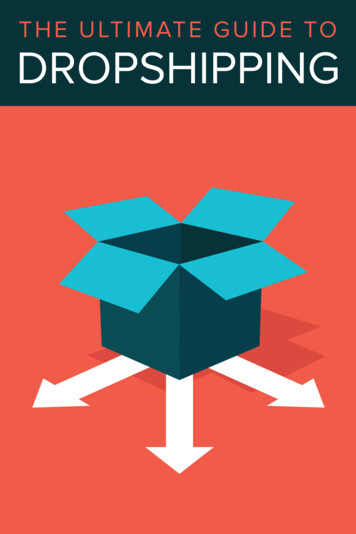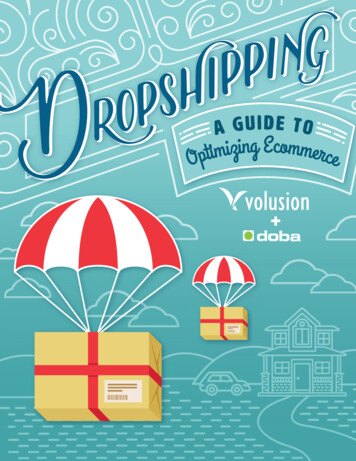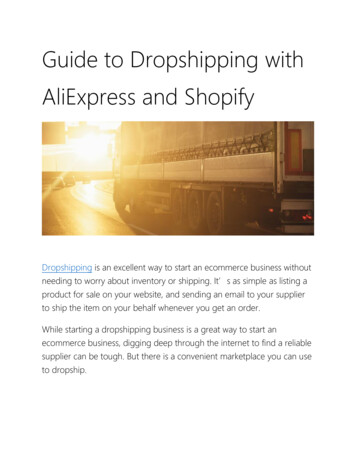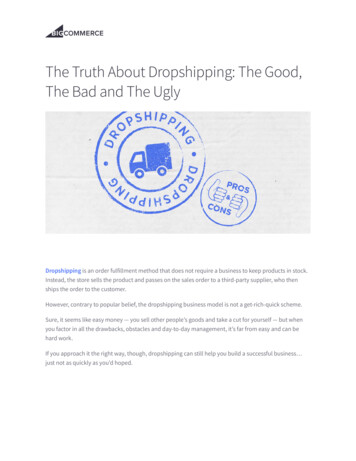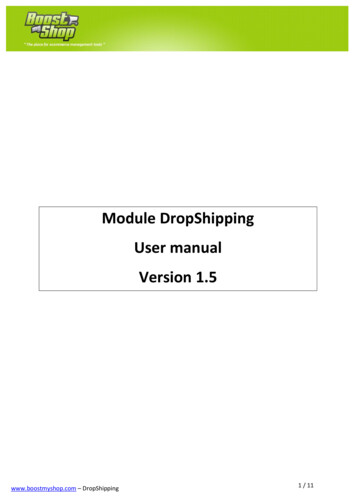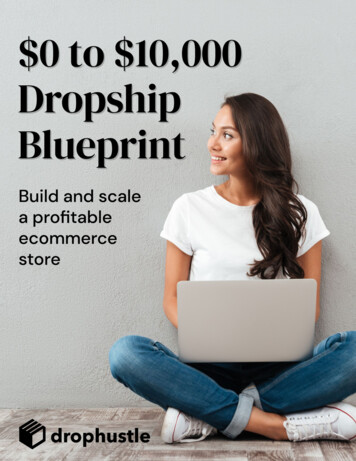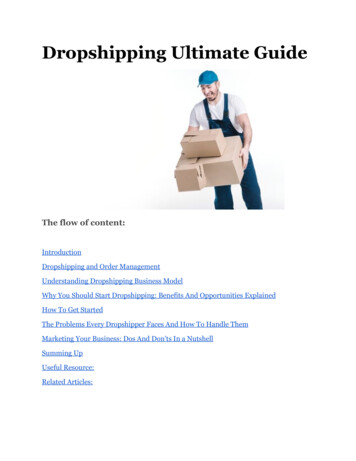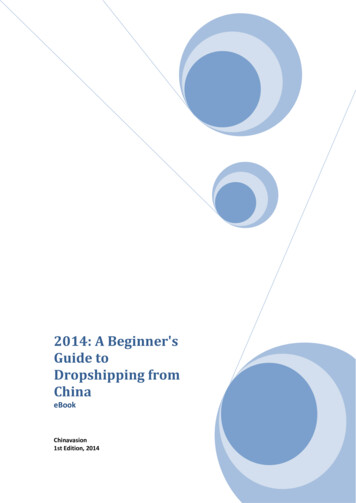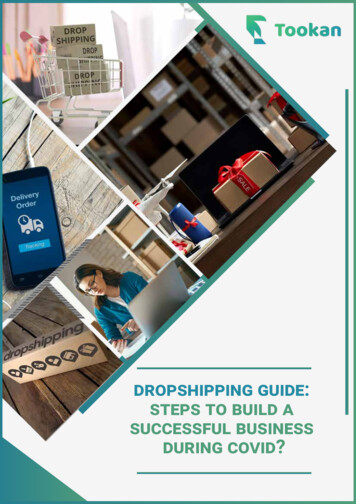
Transcription
dropshipping guide:steps to build asuccessful businessduring covid?
IntroductionChapter1- What is Dropshipping?Chapter2- Dropshipping- Business Model2.1 Segments of Customers2.2 Key Stakeholders2.3 Key ResourcesCONTENTS2.4 Key Activities2.5 Value Proposition2.6 Source of RevenueChapter3- Drop shipping- Demand Analysis3.1 Market Identification3.2 Business Cycle3.3 Product Niche3.4 Competitor AnalysisChapter4- Drop Shipping Business Model: A SWOTAnalysis4.1 Strength4.2 Weakness4.3 Opportunity4.4 ThreatsConclusion
introductionDionna Dorsey wanted to spread the positivity of her community of creativepeople around through her full-time job - “Dionna Dorsey Design.” This ideagave her the push to create a drop-shipping marketplace called District ofClothing back in 2014.Dionna started the drop-shipping project as a side hustle back in 2014, and by2016 she made 29K extra on her earnings from a full-time job. Now she owns afull-fledged print-on-demand drop shipping firm with a massive user base.A drop-shipping marketplace is a business approach where you only need topass consumer’s orders directly to the suppliers or manufacturers. Then youpurchase those items from the supplier and deliver them to the customer. Thereare no storages or inventories to stock the product. Such an approach ispopular among many eCommerce giants like Amazon and eBay. Especiallyduring this pandemic, when physical shopping is losing its charm,drop-shipping is becoming ideal for many businesses. With the restrictions ofmovements and imposed lockdowns due to multiple waves of COVID19infections, warehousing is also not that easy. Drop-shipping eliminates theneed for inventory and thus remains ideal for businesses looking to grow in thecurrent scenario. With an estimated 125.45 billion revenue alone in the US by2027, the drop-shipping market is on the rise. So, if you are looking to mimic themassive success of giants like Amazon or even create a side hustle like Dionna,here is everything you need to know from the business model and sourcerevenue to the demand analysis and SWOT analysis of the drop-shippingmarket.Let’s first know what drop shipping is and how this industry is disrupting theeCommerce landscape.
Chapter 1What is Dropshipping?Dropshipping is a business approach where the product fulfilment does notinvolve inventory or the activity of keeping the product stock. The items orderedby customers are shipped directly from the manufacturer or wholesale supplierto the customer. Dropshipping company acts as a facilitator that helps theconsumers select the products from different categories.A third-party retailer or drop shipping firm will pass on the order for a product tothe supplier for a wholesale price while charging the retail price to the customer.It uses an online platform to facilitate the transaction between the customers andthe supplier.Here is how it works:Next, they integratethese products intotheir dropshippingmarketplace platformsthrough digital tools likewebsites or shipper sourcesproducts at wholesalerates from independentsuppliers, third-partyvendors, and evenmanufacturers.Consumers chooseproducts from thewebsite and makepurchase orders thatthe dropshipping firmmanages.IMPORTNow, these dropshippersimport items to onlinestores and set retail prices.Any third-party vendor ordropshipping companyhas complete control overthe profit margins and finalpricing.Your suppliers willship the order directlyto the customer’saddress and offer atracking number toyou in the system. So,you can easily updateyour consumersregarding packagedelivery and evenallow users to track it.If the supplier iscapable of whitelabel shippingservices, you caneven add brandingon each Orders are forwarded tosuppliers with all theshipping details, andpayment is made onbehalf of consumers.
Over the years, dropshipping marketplace platforms have garnered attentionfrom many different investors and enterprises looking for higher revenues. Let’slook at the industry trends and market value of drop shipping marketplaceplatforms:More than 27% of theRetailers around theWorld have turned toDrop-shipping modelsfor Higher profits(E-Commerce Platform).The drop shippingmarket was valued at 162.44 billion in 2019 andis fore casted to growwith a compound annualgrowth rate of 18.3%(Business-wire).50% of the sales onthe Amazon marketplacecome from third-partysellers (TorchBankz).eCommerce retailersusing the dropshippingbusiness model can earn50% more profits thantheir counterparts optingfor onsite inventory.MARKETPLACEPLATFORMSMore than 25% ofFrench dropshippingbusinesses offer jewelleryand accessories nicheproducts, while 13% ofthe dropshippers dealin the fashion industry(Statista)The global dropshipping market will beworth 167 Billion by theend of 2021(GlobalViewResearch).The drop-shippingmarket will reachrevenues of 591.77Billion by the end of2027 (Business-wire).
One of the most interesting aspects of the dropshipping market is that almostall eCommerce retailers have tried the model at least once. For example,Amazon, eBay, or even Walmart, all offer some of the products in their listingsthat are dropshipped. These eCommerce giants dropship bigger brandsacross different niches, where they act more as facilitators.Take an example of the iPhone stores on the Amazon marketplace or even theReebok section in a Walmart app. What makes it an opportunity for other smalland medium players in the market is that these eCommerce giants chargemore due to inventory costs. At the same time, you can use the dropship modelin its entirety to offer more competitive prices
Chapter 2Dropshipping- Business ModelWith the current predicament of eCommerce businesses and on-demandmodels dealing with the pandemic situation, dropshipping business offersuniqueness in many ways. It offers flexibility in doing business which is notthat easy with other business models as there is a physical interaction inone form or another. The scale of a business can be big or small based onyour organisational goals, and there is no limit.Choosing dropshipping as your core business is a great idea, but you needto understand that the kind of revenue you have in mind may take sometime to generate.However, dropshipping allows businesses to scale up quickly and curb thecosts by a considerable margin. So, there is no denying the fact that itseems to be a lucrative prospect. The execution of your business logic andthe right tech stack can help you build a successful dropshipping business.Let's now look at some of the critical aspects of this business model.
2.1 Segments of CustomersPLATFORM USERSPlatform Users are the end customersof any dropshipping firms that placethe order from different categories ofproducts on the platform. Theyengage with the platform and pay aretail price of the product on theportal, which may or may not includedelivery charges.VENDORS/SUPPLIERSVendors/Suppliers are the sellers thatuse the platform to showcase theirproducts. However, there is adifference between other marketplaceplatforms and dropshippingplatforms. Here, the sellers don’tcharge the product’s price directly tocustomers, but the final retail pricealso includes the profit margin of thedropshipping firm.2.2 Key StakeholdersDropshipping business model makes the inventory element redundant, andthat is why there are only two key stakeholdersCUSTOMERSplace the order and pay a retail pricethat includes the dropshipping firm’scommission or cut.THIRD-PARTY SUPPLIERdelivers the orders directly to thecustomer’s location after receivingorders from the dropshipping firm.2.3 Key ResourcesOnline Marketplace Platform- Where consumers can view products and place orders.AI-based Algorithms- These algorithms calculate the estimated price by addingcommission on top of the wholesale price charged by the supplier.Third-party supplier- delivers the orders directly to the customer’s location afterreceiving orders from the dropshipping firm.
2.4 Key ActivitiesAny dropshipping firm is involved in two primary activities-Maintaining value forconsumers through theaddition of listing fromdifferent suppliers andvendors.Helping differentvendors andthird-party suppliers tosell their products onthe platform andmanage orders forthem.2.5 Value PropositionEnd CustomerFor every consumer, the value that a dropshipping firm offers is several categoriesof products in one place, so they don’t need to browse different sources for it. Adropshipping model also allows consumers to easily access unique products likedesigner apparel, special devices, and even customised products from thecomfort of their homes.Supplier/Third-party VendorEvery supplier gets a platform to showcase their products and reach newcustomers. As the volume of platform visitors increases, demand for productsincreases resulting in higher sales and better revenues.
2.6 Source of RevenueA dropshipping firm profits by sourcing products atwholesale prices from the suppliers and selling them atretail prices. This price includes every cost incurred bydropshipping firms plus the commission. It covers deliverycharge, wholesale price, dropshippers profit, individualexpenses, and even payment gateway charges.For example, a dropshipping firm charges around 20- 50 for products sourced at a price range of 1- 20.So, the final profit margin after excluding all the costs andcharges remains anywhere between 40%-70%, which isenough to sustain any dropshipping firm.However, if you have enough financial backing and canafford to sustain at lower profit margins, then keeping theprices more aggressive does help grow your business.
Chapter 3Dropshipping- Demand AnalysisDropshipping business models have a broad spectrum of niche productslisted on a marketplace platform, and that is why demand forecasting is notsimple. With more retailers choosing to drop ship products, the market hasgained momentum. However, finding the right vendors and suppliers in theinitial stages is not easy.The reason behind this issue is a lack of understanding on what is theconsumer’s demand from the platform. In the initial phase, dropshipping firmssource more vendors to offer products across several categories. Due to thepressure of adding more value for consumers on the platform, many startupstend to source products from unreliable suppliers.The best way for organizations to handle this problem is by analyzing thedemand for products on their platform. From exploring the traffic on yourplatform to understanding the demand of product categories, demandanalysis can help dropshippers improve their revenues.
There are four steps that any dropshipping firm needs to follow fordemand ycleCompetitorAnalysis3.1 Market IdentificationMarket identification is an activity where you can have an understanding ofthe current sentiments of customers. It allows a drop shipper to understandthe gap between existing offerings and customer’s expectations. So, you canfill that void through a reliable dropshipping solution.Market identification program can arketPeers ReviewOnlineReviews andSurveysOnce you have identified your market, you can then look to identify the businesscycle of your model.
3.2 Business CycleOnce you know the market and its potential, the next thing that should beprioritized is to understand the business cycle. Such an analysis will help yousee the phase at which the current market stands in the business cycleinitial, mature, and saturationINITIAL STAGEMATURE STAGESATURATED STAGEMarkets in this stagehave a high demandfor products, andthere is morepotential for growth.Here, the dropshipperscan leverage alreadyset market trends and apool of consumersalready loyal tothe model.This stage showcasesthe saturation in themarket, and sales startdeclining for mostbusinesses.When you know at which stage the market is, you can speculate the salesand even demand of customers.3.3 Product NicheFinding the niche is essential not only for understanding the customerdemand but also for products they prefer. Most dropshippers look to establishtheir brand in a product niche at the initial stage of the business cycle. It helpsthem to achieve better sales with customers.Take an example of the Only Natural Pet. It is a marketplace platform for petowners to find natural food, flea repellants, outdoor gear, and more for theirpets. The niche marketplace is a part of the 99 billion pet industry.
3.4 Competitor AnalysisCompetitor analysis is essential to dropshipping firms as it helps youunderstand the pricing structure and customer demand. For example, you canresearch your competitor and know whether they have a policy for MinimumAdvertised Pricing (MAP). If your competitor is following MAP for theirmarketplace, you can keep the prices competitive and attract more consumers.At the end of demand analysis, you will have data on three aspects ofdropshipping business his data will help you formulate a dropshipping business model, which willrender great results! Now that you know what dropshipping is, understood thebusiness model, and have an understanding of demand analysis, you need toperform a SWOT analysis. It helps with the identification of all the bottlenecksthat can come with the execution of this model.
Chapter 3-Dropshipping Business Model: Aswot Analysis4.1 StrengthStrength analysis will help you understand the good aspects of your business. Itenables you to draw essential points useful not only from a business perspectivebut also for branding your dropshipping business.Ease ofShoppingConsumers canorder products fromyour online storeswithout any needfor physicalinteraction with thebusiness.WorldwideOperationsThere is norestriction to theoperationalcapabilities as youcan scale yourdropshippingbusiness to anycountry in theworld.Lower InitialCostsThere is no need fora physical setup asthe inventory partis redundant withthe dropshippingapproach.OnlinePaymentsThe ease ofmultiple paymentoptions can besignificant forcustomers anddrop shippers as itreduces the risk ofcash crunch.
4.2 WeaknessWeakness identification will help your organization to understand the pitfalls andplan accordingly. It also enables dropshippers to improve their business modeland reduce risks.Once the order is passedon to the supplier, there isno control over it by thedropshipper. From shippingcharges to the deliveryschedule, everythingdepends on the supplier.Lack of ControlThis depends on the marketniche; some suppliers offerpersonalization, while othersdon’t provide such a facility.ConsumerBehaviorThere is no customerloyalty, and everythingdepends on the pricing. So,it is hard for dropshippingcompanies to determineconsumer behavior.NoPersonalization
4.3 OpportunityOpportunity analysis will help you understand how you can exploit thedropshipping model for growth.Max RevenuesWith no need forstocking theproducts, thedropshipping modelcan be a goldminefor many startupsand organizations.Dropshipping modelis growing, and allyou need is aroadmap to tap intothe market’spotential. In thepresent scenario,online stores arebooming due to thepandemic and thatis a greatopportunityMax. CategoriesThere is no limit tothe type of productsyou can add to yourdropshippingmarketplace, andthat is an excellentopportunity for anybusiness with highervolumes of sales.Growth Road-map4.4 ThreatsThese are your red lights on the growth road, so knowing them helps avoid anythreat! It enables you to understand the real issues you need to avert for asuccessful dropshipping business.CompetitionWith a global reach,competition ishigher, and that is amassive threat forany business lookingto exploitdropshippingbusiness model.Keeping the pricescompetitive is noteasy, and thatrestricts the profitmargin. However, thedropshippingbusiness model is allabout volumes, andthat is why it’s thesales that mattermore than margins.Profit MarginCompliance &RegulationsThere are taxationsin many countriesapplied to onlinesales, which maydent your margins.Apart from themargins, anothercritical aspect is thecompliance ofproduct deliverynorms and otherrestrictions of goodsmovement due topandemic.
conclusionDropshipping’s business model has its fair share of weaknesses and threats,but its strength outweighs these pitfalls. The bottom line of any business isrevenues, and for dropshippers, the primary source is the tech stack withwhich a user interacts for transactions.Developing a reliable tech stack will help you improve the user experience andenable improved checkout processes. Better checkouts mean higher sales,and you will never lose on deals.For enterprises and organizations looking to leverage dropshipping within theireCommerce solutions, integrating a reliable tech stack can open new doors.Even with a situation like the current pandemic forcing the physicalinteractions to be minimum, a reliable tech-based solution can help yourdropshipping business.So, whatever your requirements, if you are looking to tap into the dropshippingmarket, Tookan by JungleWorks can help you create a reliable tech stack. It isa smart order management software that allows you to automate youroperations, and access every detail of the order in real-time. Want to ace thegame of dropshipping, contact Tookan today!
Choosing dropshipping as your core business is a great idea, but you need to understand that the kind of revenue you have in mind may take some time to generate. However, dropshipping allows businesses to scale up quickly and curb the costs by a considerable margin. So, there is no d
